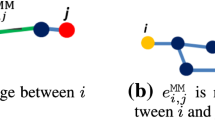Abstract
The clustering of vector observations of hyperplanes is studied. Different cases of correspondence distances are proposed and investigated, including the algebraic Jack Knife one. The efficiency, constructivity, and explicit form of formulas are provided by using the pseudoinverse technique including the pseudoinverse-perturbation theory. Results important for the application of pseudoinverse and related operators are presented.
Similar content being viewed by others
References
A. Albert, Regression, Pseudoinversion, and Recurrent Estimation [Russian translation], Nauka, Moscow (1977).
N. F. Kirichenko, “Analytical representation of perturbations of pseudoinverse matrices,” Cybern. Syst. Analysis, 33, No. 2, 230–238 (1997).
N. F. Kirichenko and N. P. Lepekha, “Application of pseudoinverse and projective matrices to studying control, observation, and identification problems,” Cybern. Syst. Analysis, 38, No. 4, 568–585 (2002).
V. N. Vapnik, Statistical Learning Theory, Wiley, New York (1998).
S. Haykin, Neural Networks. A Comprehensive Foundation, Prentice Hall, New Jersey (1999).
M. F. Kirichenko and V. S. Donchenko, “A terminal observation problem for dynamic systems: Multiplicity of solutions and optimization,” Zh. Obchysl. Prykl. Matem., Issue 3, 63–78 (2005).
E. H. Moore, “On the reciprocal of the general algebraic matrix,” Bull. Amer. Mathemat. Soc., 26, 394–395 (1920).
R. Penrose, “A generalized inverse for matrices,” Proc. Cambridge Philosoph. Soc., 51, 406–413 (1955).
N. F. Kirichenko, V. S. Donchenko, and D. P. Serbaev, “Nonlinear recursive regression transformers: dynamic systems and optimization,” Cybern. Syst. Analysis, 41, No. 3, 364–373 (2005).
V. S. Donchenko, M. F. Kirichenko, and Yu. G. Krivonos, “Generalizing of neural nets: functional nets of special type,” in: Proc. 12th Intern. Knowledge-Dialogue-Solution Conf., June 20–25, 2006, Varna (2006), pp. 63–69.
B. Efron, Nonconventional Methods of Multivariate Statistical Analysis [in Russian], Financy i Statistika, Moscow (1988).
Author information
Authors and Affiliations
Additional information
__________
Translated from Kibernetika i Sistemnyi Analiz, No. 4, pp. 73–92, July–August 2007.
Rights and permissions
About this article
Cite this article
Kirichenko, N.F., Donchenko, V.S. Pseudoinverse in clustering problems. Cybern Syst Anal 43, 527–541 (2007). https://doi.org/10.1007/s10559-007-0078-y
Received:
Issue Date:
DOI: https://doi.org/10.1007/s10559-007-0078-y




